Rapid Wien have been performing very well in this 2019/20 Austrian Bundesliga season. They’re currently sitting third in the table with 32 points, 10 points away from second-placed LASK and 12 away from table-toppers Red Bull Salzburg.
Dietmar Kühbauer‘s side have been both prolific and solid at the back this season. And most importantly, they have been pretty consistent – which is definitely something that they were lacking last season.
In this tactical analysis, we will take a closer look at Kühbauer’s tactical tendencies at Rapid Wien and how he manages to bring a team that struggled with mediocre performances in the previous season to an impressive title-challenging campaign.
Formations
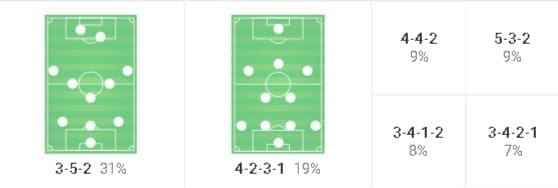
Kühbauer has been quite flexible in terms of the systems used thus far this season. As you can see above, his most-favoured system (and seemingly his most successful formation) to use is 3-5-2 (31%), meanwhile, his second most-used formation is 4-2-3-1 (19%). Occasionally, Kühbauer sometimes also chooses to tweak his tactics and formations and play in a 4-4-2, 3-4-1-2, 3-4-2-1 (3-4-3) or even a 5-3-2 formation on some occasions.
Kühbauer would often alter his team’s system in a match, either in the first or second half. He can be seen often trying to go from 4-2-3-1 to 3-5-2, or 3-5-2 to 4-2-3-1, or 3-5-2 to 3-4-3. However, despite the change of formation, their original philosophy of playing the game is still the same. We will take a better look at that later in this tactical analysis.
Build-up play
Rapid Wien have the tendency to play out from the back with the goalkeeper distributing the ball towards the nearest centre-back and play their way out of opposition pressure as you can see in the picture below.
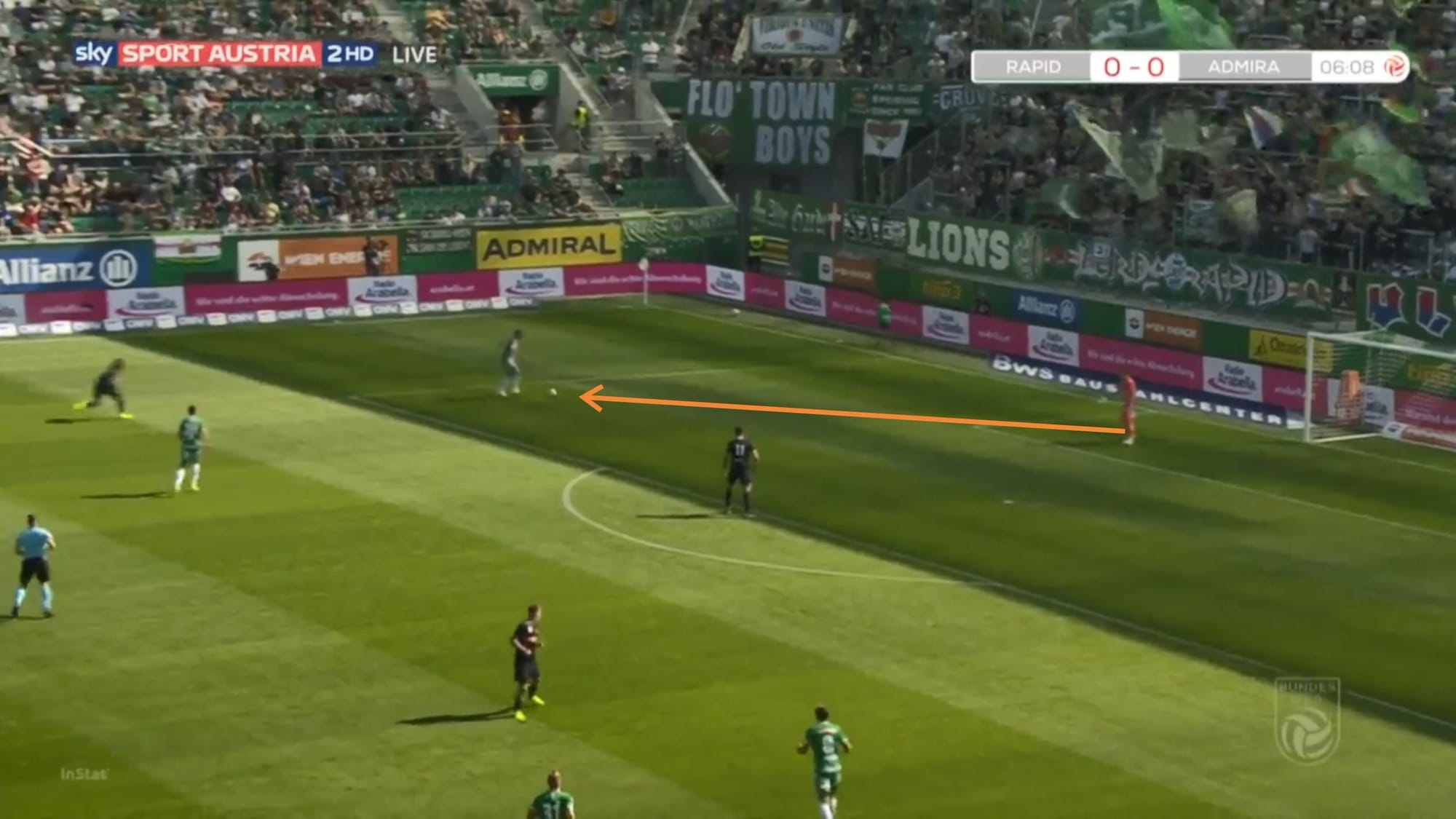
However, at some occasions, when the opposing team decide to mark Rapid Wien players man for man and block high, the goalkeeper will decide to distribute the ball long instead of playing out from the back due to the high risk of losing it in a dangerous area.
Rapid Wien have the same tendencies when building up both when playing with a four-man backline and a three-man backline: they will always bring three players to play at the back.
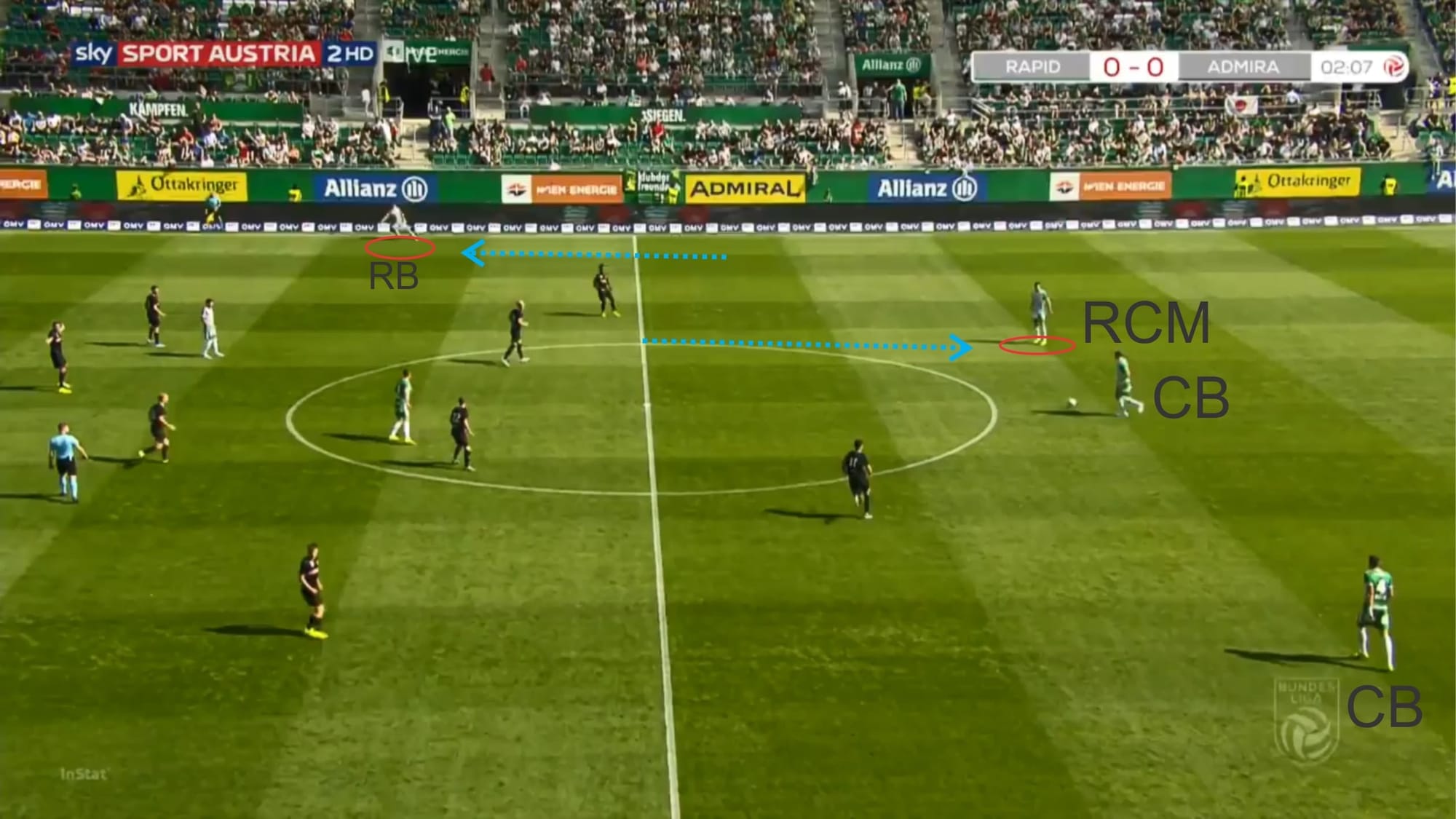
The situation above is when Rapid Wien play with a 4-2-3-1 formation. As you can see, one of the two central midfielders dropped down and sits beside (or sometimes in between) the two centre-backs.
The other centre-mid sits in front of the three-man line, aiming to be the first pass receiver in midfield as he actively moves around in search of space around the central areas.
The full-backs will sit quite high and wide, aiming to provide width and potentially exploiting the space there. Meanwhile, the wingers tend to sit narrower, occupying the half-space. The attacking midfielder is quite flexible here as he’s often found sitting in pockets of spaces centrally or often in the half-spaces to provide support to the wide men.
Pretty much the same system can also be seen when they’re utilising a three-man backline system (3-5-2) which you can also see in the picture below.
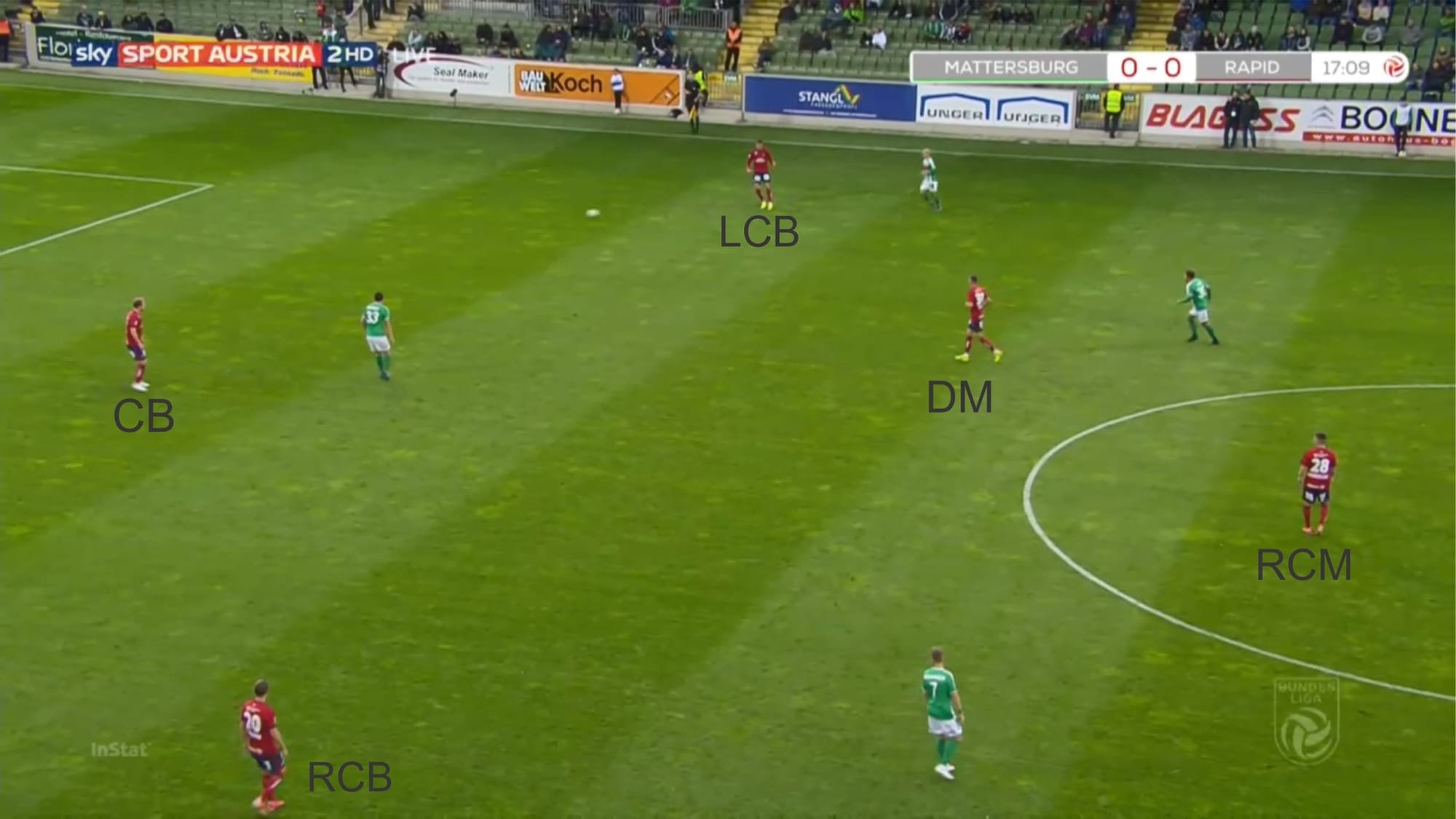
With a three-man backline, the three-man situation at the back will naturally form and the defensive midfielder will act as the first pass-receiver in midfield who looks to play the ball towards more creative players while the two central midfielders occupy the half-spaces and wing-backs stay wide.
In a 3-5-2 system, one of the strikers tends to stay in an advanced position and centrally, mainly Aliou Badji is in this role but Koya Kitagawa is occasionally deployed in this role as well. Meanwhile, the other one is the much more active, exploring spaces out wide and dropping deep quite often. Christoph Knasmüllner and Taxiarchis Fountas are usually the ones in this role and on some rather rare occasions, Philipp Schobesberger is tasked to play in this particular role too.
The picture below shows what the shape looks like when they’re in the early phase of an attack.
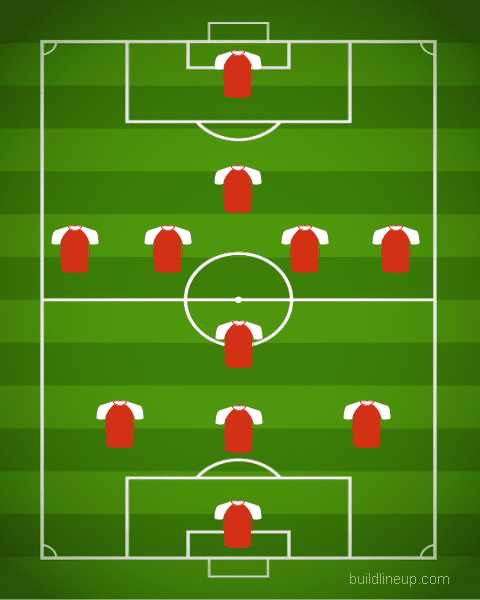
Meanwhile, once they managed to get into advanced areas in the opposing half, they’d form this shape as you can see below.
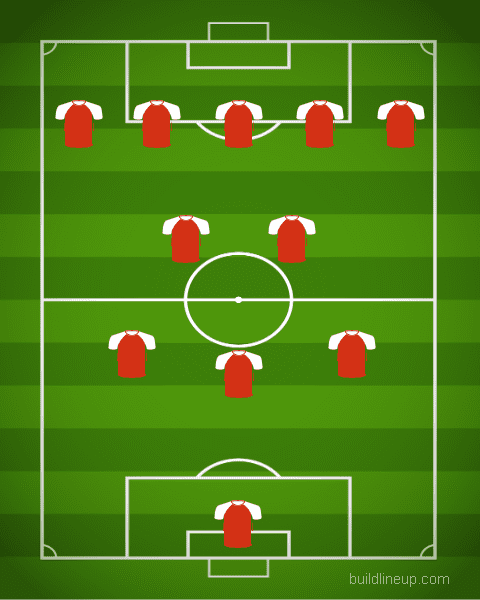
As you can see, Rapid Wien tend to attack with five players upfront while two players (usually Dejan Ljubicic and Stefan Schwab) sit in the middle third, mainly acting as the pivot and potential pressers when they lose the ball upfront. Meanwhile, three players at the back maintain a rather high line but are still wary of potential counter-attacks.
Rapid Wien are very direct and very much vertically-oriented though not necessarily relying on long balls. They tend to string out only a few passes in the build-up that lead to chance creation. They mainly use very few touches on the ball and tend to rotate the ball around and switch plays quickly to exploit spaces on the flanks.
Statistically, Rapid Wien kept possession of the ball only for an average of 10 seconds and only played an overall of 458 passes on average per game. For comparison, Red Bull Salzburg – who are also a team that tends to be quick and vertically-oriented in attack – have an average of 16 seconds ball possession and played an overall of 584 passes on average per game. This shows how Kühbauer values efficiency and speed in attack as his team play and move the ball with pace but are still precise, calculated, and not clumsy when in possession.
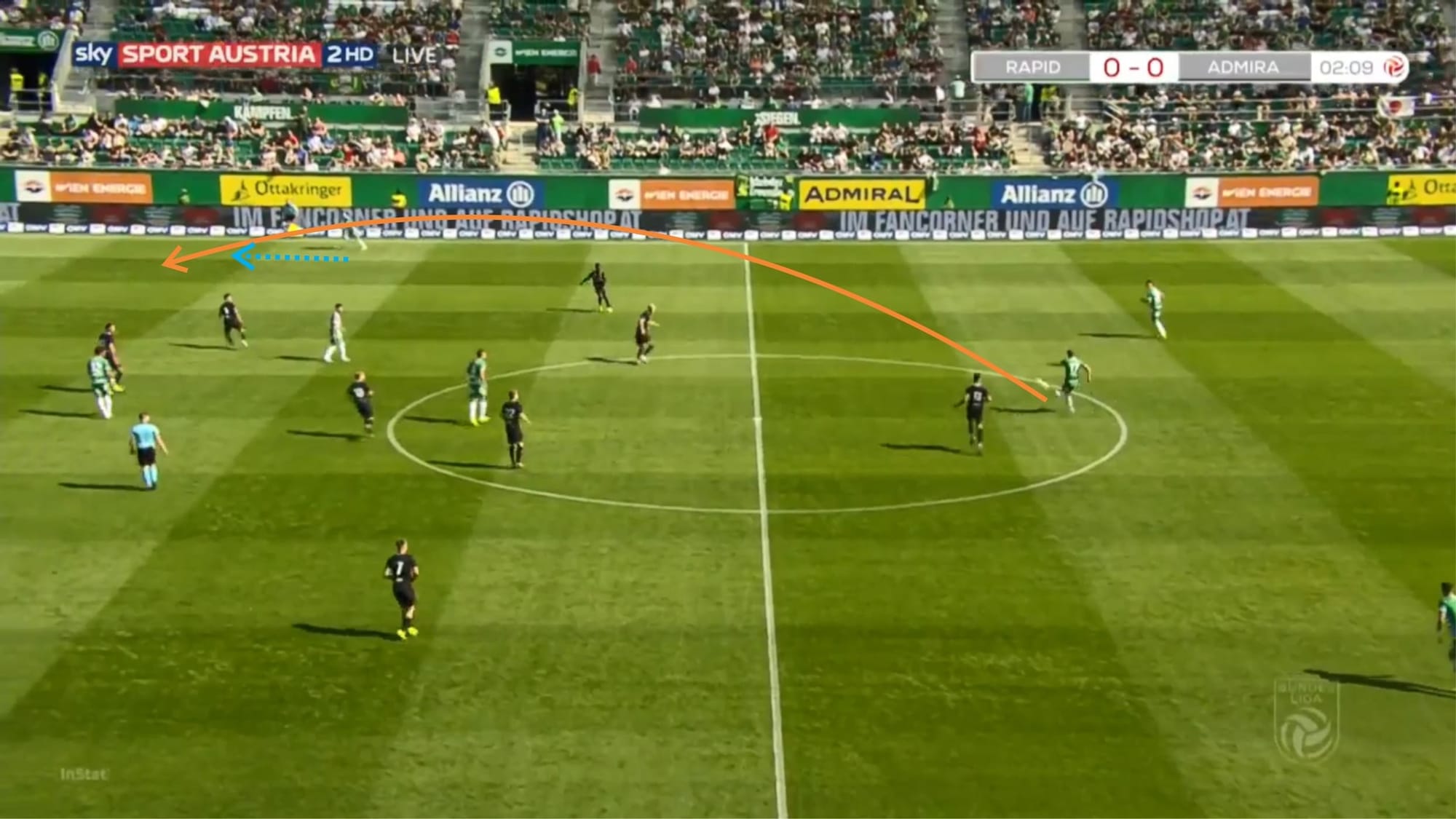
Kühbauer’s side have the tendency to exploit width by playing and progressing through the half-spaces and flanks as you can see from the picture above. There are several ways they can break forward. They can progress through the middle and then exploit flanks or they can start the attack and progress through the flanks immediately if the central areas are overcrowded.
Rapid Wien can often avoid combining centrally and go immediately to the flanks. This can happen if the opposition defend narrowly and overload the middle but leave spaces on the flanks. Rapid Wien’s back three can either give the ball diagonally towards the ball-far wide player or they can play the ball towards the ball-near wide player as can be seen in a situation below.
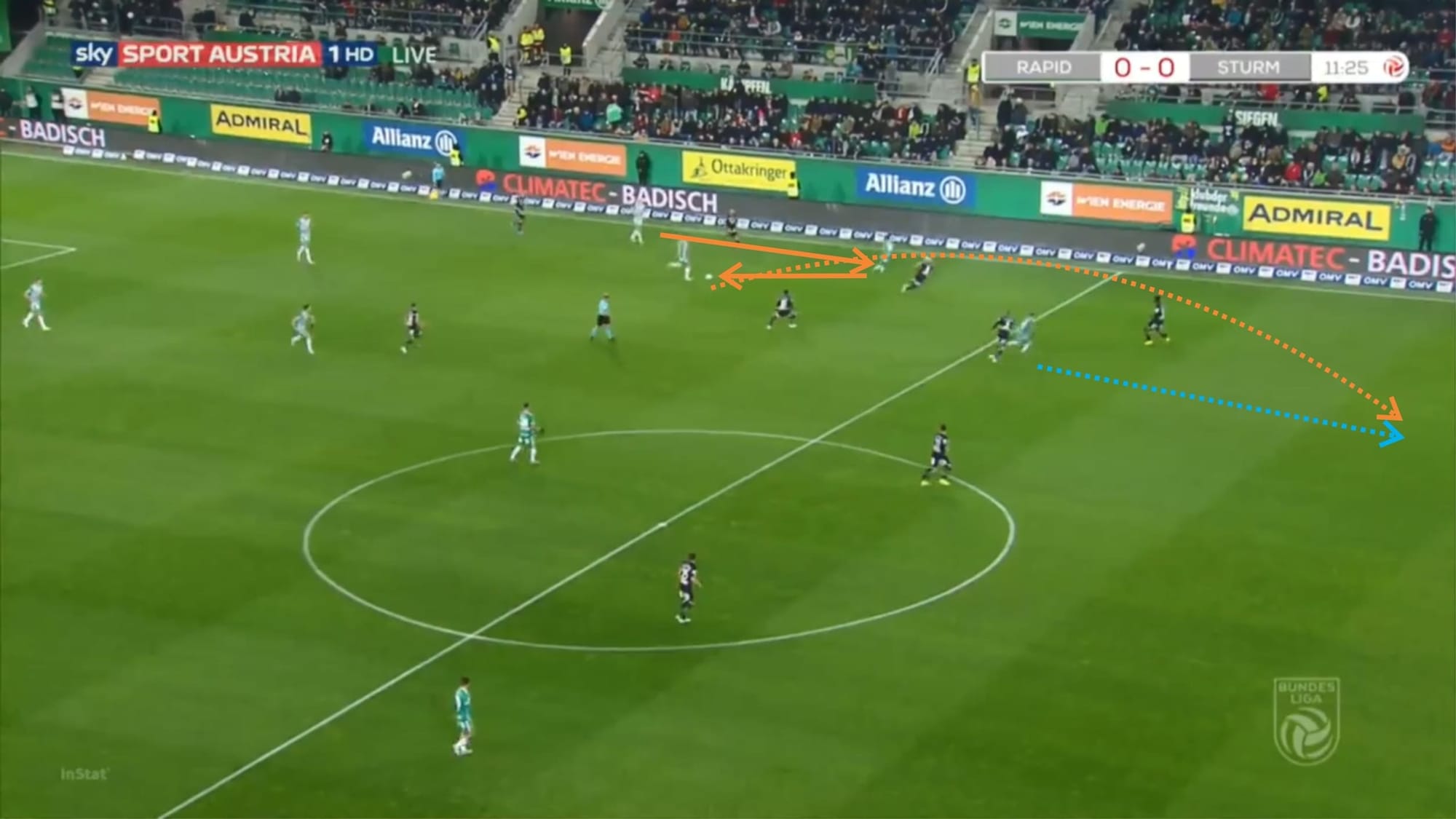
In the picture above, Mateo Barać (left-sided centre-back) gives the ball to left wing-back Maximilian Ullmann who dropped down to provide support out wide. After a brief and swift passing exchange out wide, Schwab delivers a perfect through ball into the back of the defence with Fountas running onto it.
A very simple yet quick and effective way to break the opposing team’s man-to-man marking and defensive organization. It’s also important to note that passes behind the defence are much more common rather than passes in front of the opposing backline as Rapid Wien don’t really have players who are capable of winning the first ball and holding onto it (except for Aliou Badji) but most of their strikers are explosive and have blistering pace – perfect for exploiting high defensive lines.
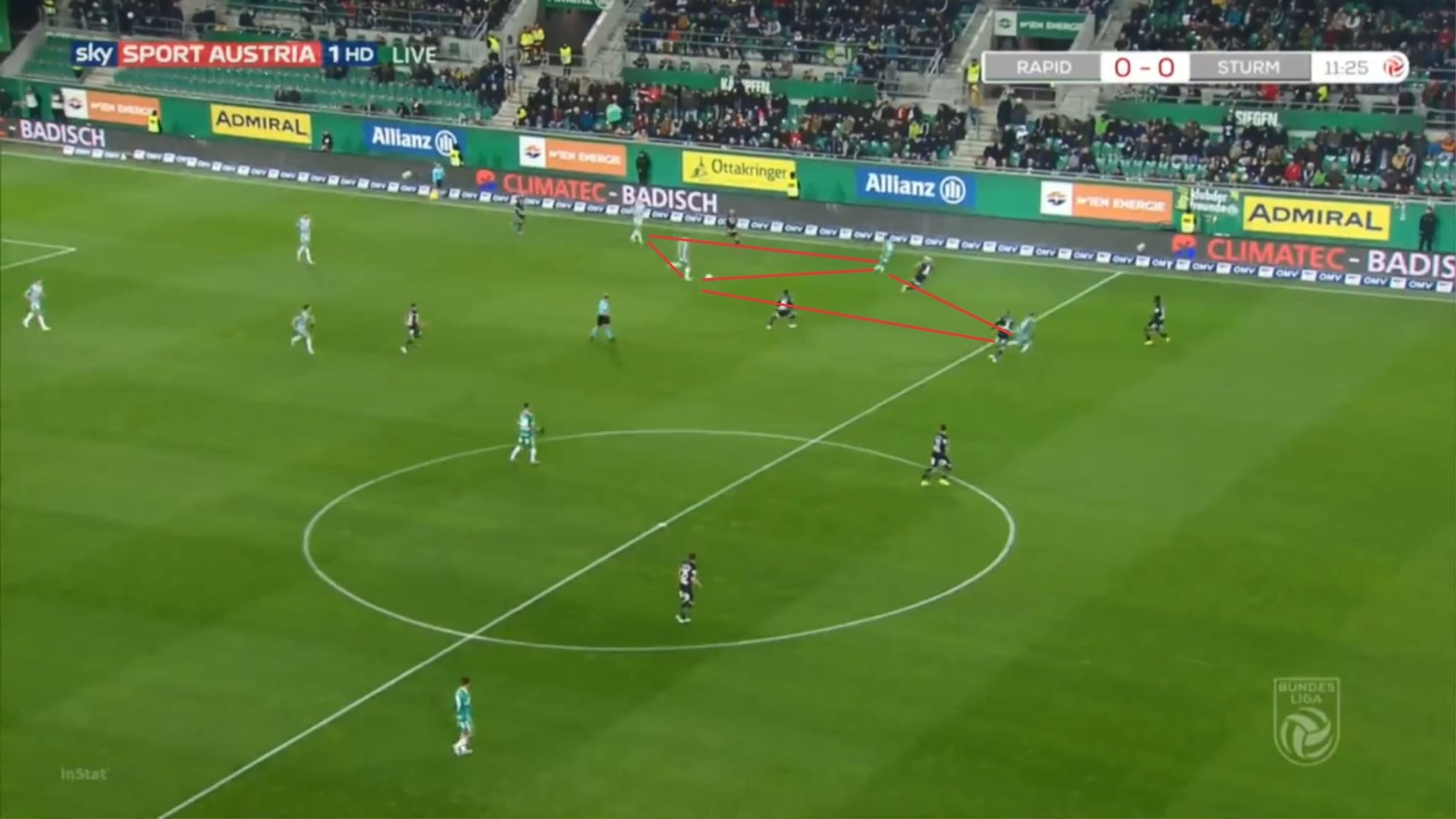
Rapid Wien seem to employ what is commonly called the “third-man concept” where the ball-receiver will often look to deliver the ball onto the feet or path of a third man rather than giving the ball back to the original passer. This means triangular shapes like what you can see above are very common to see and this also encourages active movements and positional rotations of the players as well as quick and creative thinking.
Defensive organisation
Rapid Wien defend mainly with a compact medium block. Against opposition deemed to be weaker or known to be quite vulnerable when playing out from the back, Rapid Wien would press higher and commit a higher defensive block. However, against teams who are extremely quick on the break and proficient at playing from the back, Rapid Wien would be a bit more careful in defence, however, still maintain their compact medium block. The main principles of ball-oriented pressing and option-oriented marking still apply against any teams they face.
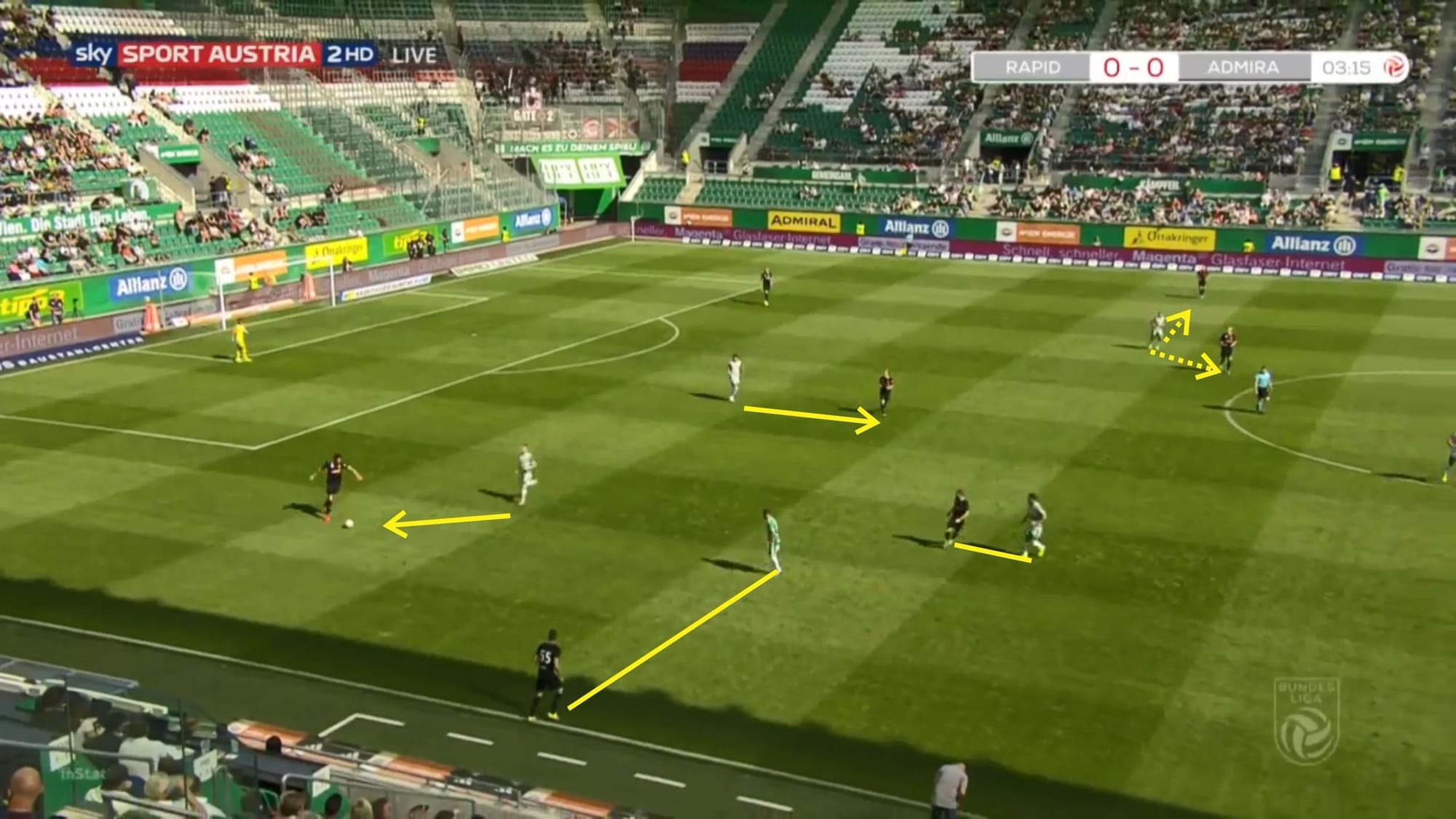
In the picture above, for example, Rapid Wien played with a 4-2-3-1 formation and defended in a 4-4-2 shape. As you can see, they blocked high against Admira Wacker and looked to press aggressively as their opponents tried to play out from the back. The two players in the first line of pressure have different jobs in defending from upfront.
While one presses the ball-carrier and looks to push him out to the flank (where the ball-carrier will have less space and be under pressure), the other player will mark the playmaker tightly to prevent the ball-carrier from escaping the pressure and progressing. The two players in the first line of pressure often switch roles depending on where the ball is.
When the ball is in wider areas, Rapid Wien will then proceed to overload that area to intensify the pressure and isolate the ball-carrier thus effectively preventing progression and potentially winning the ball back high up the pitch. You can also see that the nearest options of the ball-carrier are all man-marked, forcing the ball-carrier to either launch the ball long forwards or return the ball to the goalkeeper where Rapid Wien will then reset their defensive setup.
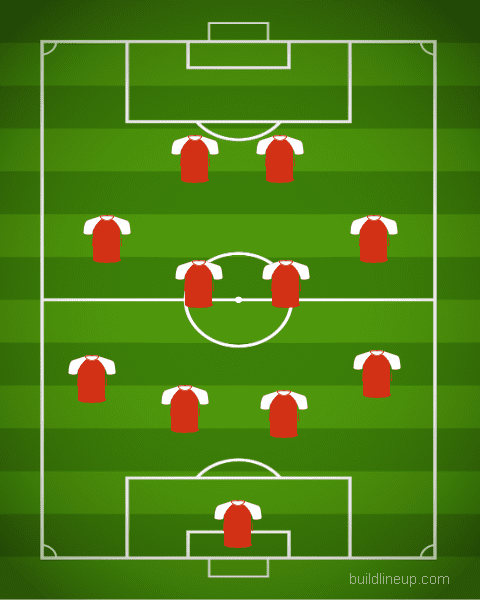
As mentioned before in this tactical analysis, in a 4-2-3-1 formation, Rapid Wien will form a 4-4-2-shaped block.
Meanwhile, in a 3-5-2 formation, the two wing-backs will drop back and sit rather deep, thus creating a 5-3-2 shape as in the picture below.
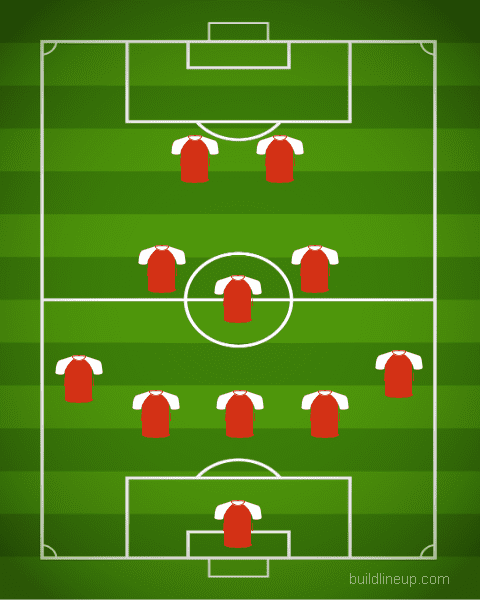
Their defensive tactics are mainly the same despite utilising a three-man backline. Although there seem to be some tweaks.
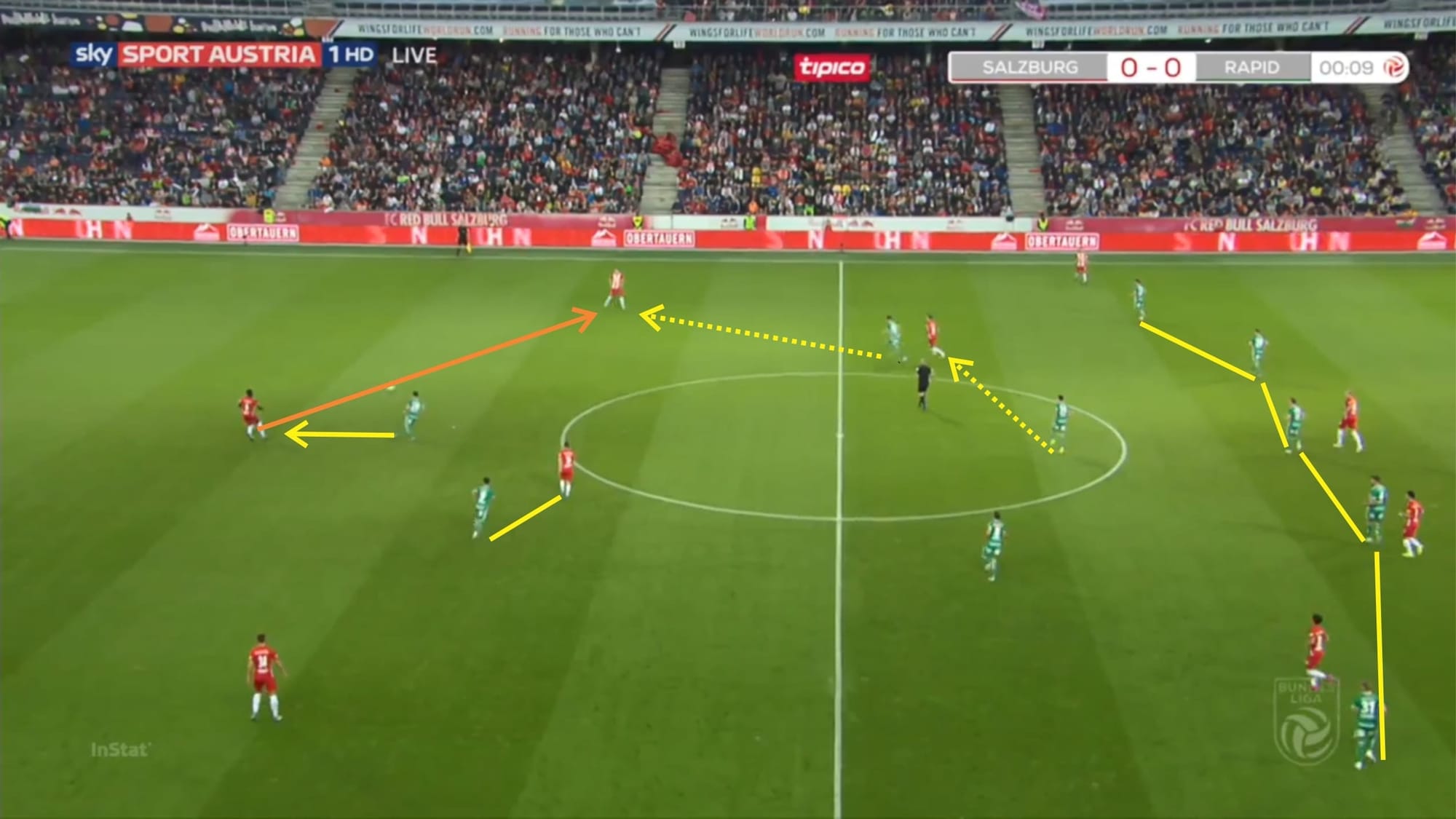
In here we can see that Rapid Wien defend with a medium block very early in the game against Salzburg. It’s not uncommon to see the second and third line stayed vertically narrow although the first line is pressing high.
As you can see, the main idea of ball-oriented pressing and option-oriented marking is still the same. Rapid Wien rely on moving their block quickly so this system demands players with high level of endurance, concentration, and overall physicality as well as speed. Fountas notably seemed to be rather poor in concentration at times, often forgetting to mark the playmaker when his teammate is pressing the ball, resulting in the opposition being able to exit the first line of pressure and progress forward with the ball.
As indicated in the picture above, Rapid Wien will move their block if the ball is played wide. The right central midfielder is already anticipating this and moves to close down the left centre-back of Salzburg. Meanwhile, the defensive midfielder will close down the left centre-midfielder of Salzburg and the ball-near Rapid Wien wing-back stays close with the Salzburg wing-back. Fountas stays close and tight to the playmaker while Knasmüllner also closes down the ball-carrier.
This way of defending from upfront usually effectively forces the opposition to play long balls forward which should be rather easy to anticipate. The compactness and lack of space for the opposition in the middle mean that they are ready to anticipate the second ball. Progressing centrally also won’t be easy for the opponents as Rapid Wien players will quickly close down space and aggressively pressure the ball-carrier. Especially once they managed to reach the middle-third. Due to this opposing teams usually have the tendency to exploit flanks when playing against Rapid Wien.
Transitions
Rapid Wien tend to quickly press after losing possession upfront.
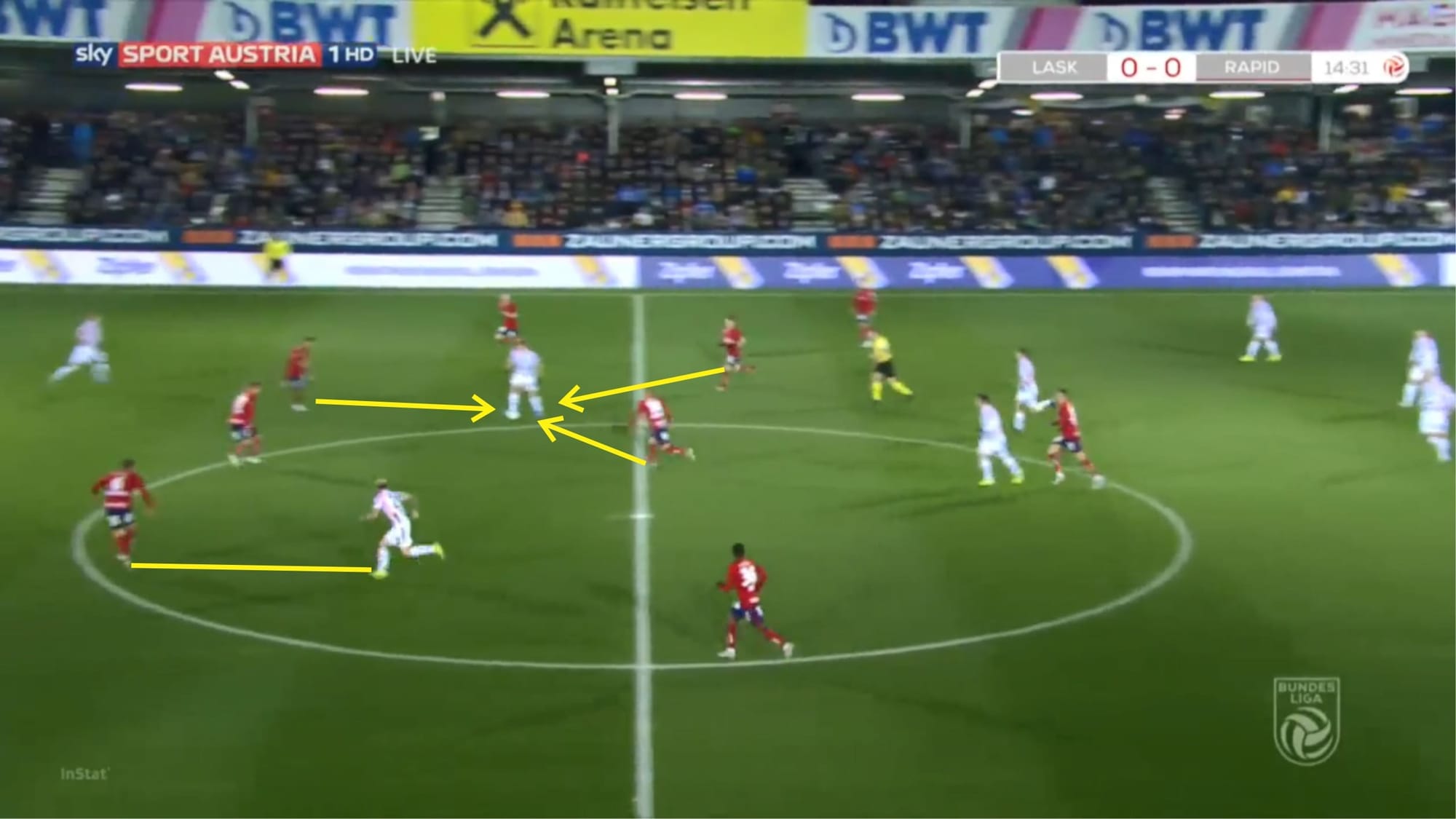
This is mainly so that they can win the ball back high up the pitch or at least to delay or cancel out opposing team’s counter-attack. Often Rapid Wien will press one ball-carrier with multiple players, but some other times only one player will press while the other one blocks the passing lane or marks the ball carrier’s options. The defensive line also seems to maintain its height rather than drop down. This is to give even more pressure to the opposing team who’s trying to launch a counter-attack and potentially trapping them offside.
Meanwhile, in attacking transition, Rapid Wien mainly look to exploit the space on the flanks or in the back of the opposing defence.
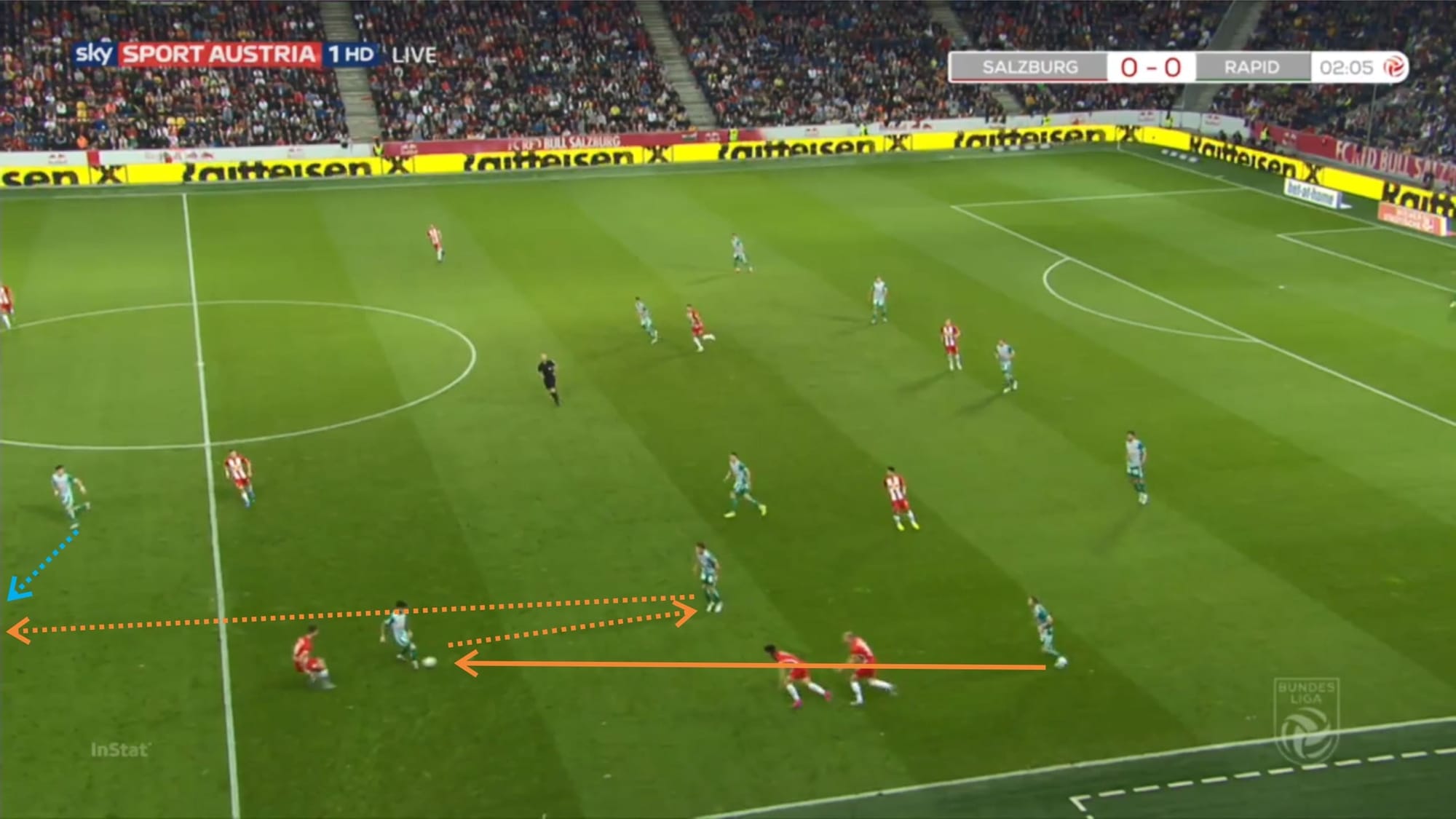
In the situation above, for example, you can see that instead of making a run centrally, Fountas look to make an outward run. In this situation, after winning the ball back on the left side of the field, Rapid Wien quickly combined in the half-space using only one-two touches before releasing the ball forward into space.
Sometimes, Rapid Wien will use long direct passes from the back instead of short-medium passes in their attacking transition, but mainly this situation above is the most commonly occurring attacking transition pattern. It’s a very similar pattern as in their attacking phase, mainly using the third-man concept and exploiting width.
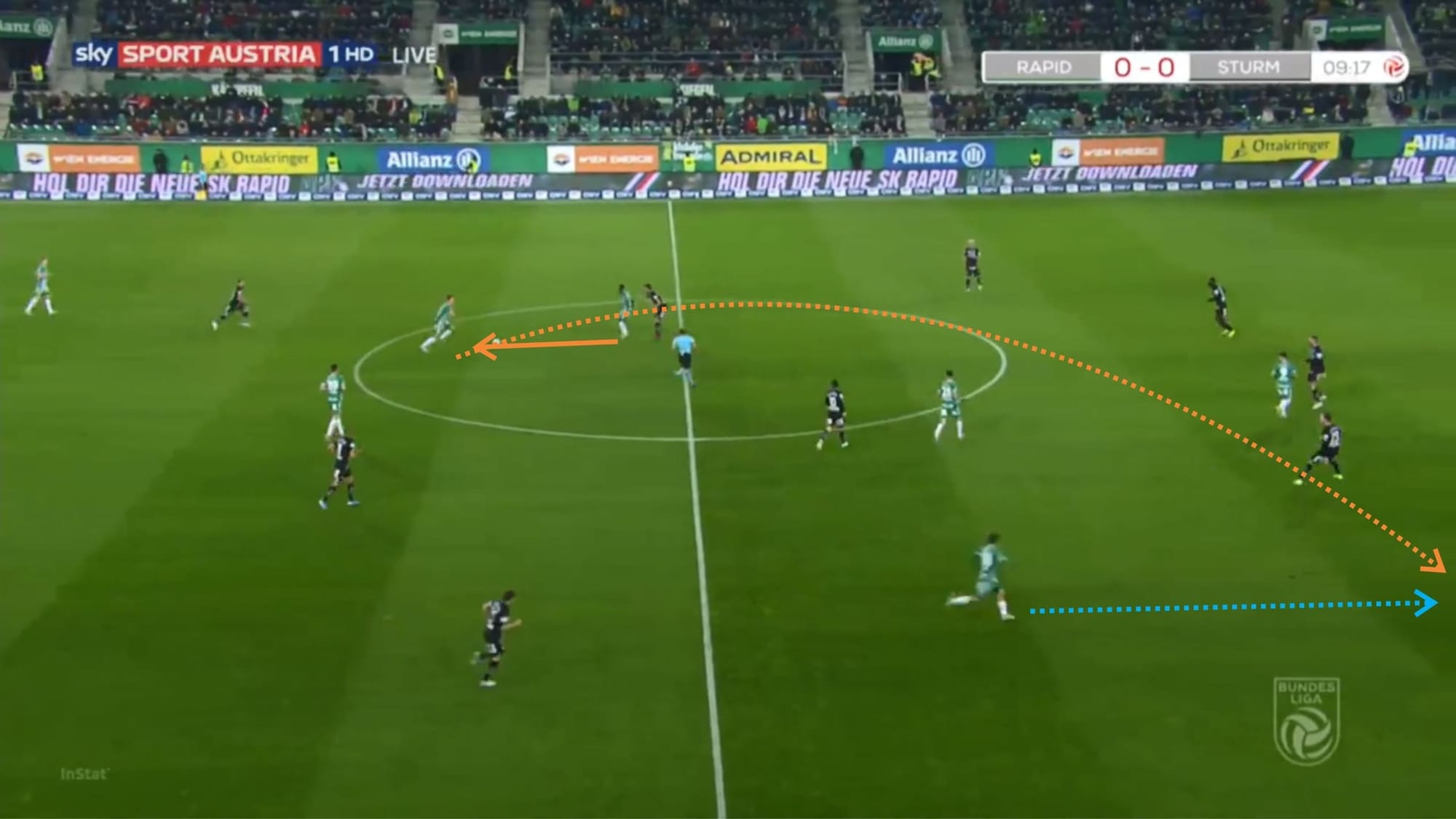
The same thing can also be seen in the picture above. After regaining possession in the middle third, the central midfielder combines quickly with his teammate before launching a well-weighted and well-timed pass onto the path of Thomas Murg out wide.
As mentioned earlier in this tactical analysis, Rapid Wien like to exploit the flanks in attacking transition so wide players (wingers, full-backs, and wing-backs) will immediately make a forward run every time they manage to regain possession. The strikers will often make an outward run rather than inward, seemingly in an attempt to drag the centre-back away from his supposed post, allowing a Rapid Wien player to make a run in the far-post to attack the ball in the final third/inside the box.
Conclusion
Rapid Wien are a team that don’t dwell on the ball for too long. They’re very effective in possession, vertical-oriented, and direct – although they don’t necessarily use long balls all the time. Using very few touches to combine quickly and using a mixture of short, medium, and long passes – Rapid Wien are very straightforward in attack and like to break forward very quickly when given licence to do so.
Their effectiveness in front of goal and the usage of explosive players upfront have been key in their campaign as they are currently the third most prolific team in the league, scoring 38 goals, just behind RB Salzburg (66) and Wolfsberger (41).
However, a lot of Rapid Wien’s conceded goals were the result of counter-attacks. Their backline seemed to lack pace and when exploited, they could be in extreme danger.
As mentioned before in this tactical analysis, Rapid Wien also tend to overload one side of the pitch when defending, which means that often times, the opposing team will try to exploit that by quickly switching the play towards the other flank. Rapid Wien players need to be quick and disciplined as well as concentrated at all times in defence to stay compact and defend as a unit. Whenever they’re too slow when moving their block, the opposition are often able to take great advantage of them.

If you love tactical analysis, then you’ll love the digital magazines from totalfootballanalysis.com – a guaranteed 100+ pages of pure tactical analysis covering topics from the Premier League, Serie A, La Liga, Bundesliga and many, many more. Buy your copy of the December issue for just ₤4.99 here




Comments